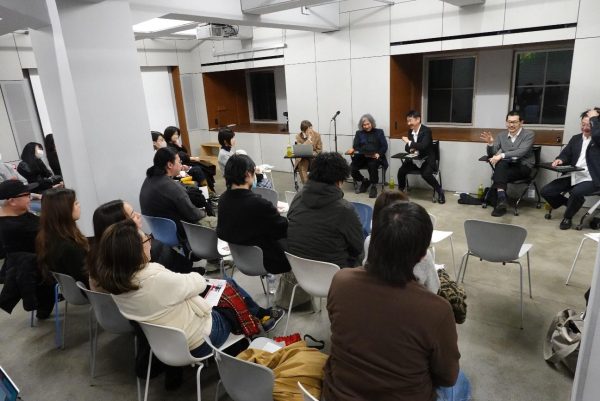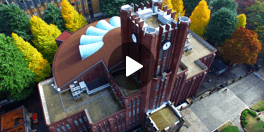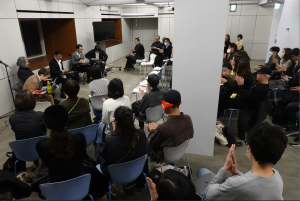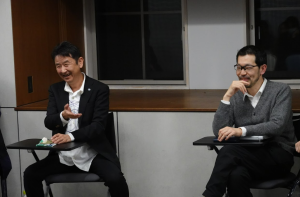
April 8, 2024
福島芸術講活動報告会レポートReport of Fukushima Association for the Arts (FAFTA)
2024年3月22日、東京大学情報学環オープンスタジオで、開沼博研究室が主催する「福島芸術講」の2023年度活動報告会が開催されました。福島芸術講とは、開沼准教授が作家・古川日出男、写真家・大森克己とともに立ち上げた芸術プロジェクトで、経産省「令和5年度 芸術家の中期滞在制作支援事業」に採択されています。
「東日本大震災・原子力災害からの復興プロセスの記録・記憶を残すという目的の縁の上に、定期的に集い、日常性・持続性の上に成り立つ、革新、創造あるいは相互扶助の場としてのゆるやかな集団」を目指すこの「講」のメンバーは、2021年に福島第一原発フィールドレコーディング作品「選別と解釈と饒舌さの共生」をリリース。本作は、編集者・都築響一の「ROADSIDERS’ weekly号 2021年03月10日」での特集、2023年夏に開催された第23回ソウル国際オルタナティブ映像芸術祭への招待・上映など多領域において注目を集めてきました。
報告会は元『GINZA』編集長・中島敏子さんの進行によるトークショーの形式で行われました。オープニングでは災害やその復興プロセスを後世に伝えることの重要性や、五輪や万博、SNS炎上に象徴される現代社会の「祭」的なものが抱える問題の枠を超える「講」や「芸術」の可能性について開沼准教授のショートレクチャーがあり、その後、写真家の大森克己さんと作家の古川日出男さんとともに、写真や文学、そして音声・フィールドレコーディングを通じた作品のあり方や意義についてディスカッションがなされました。「『分断』という概念を安易に使う主体自体が分断をまねき、またそれを望んでいる現実」「写真のフレームがオーディエンスに与えるメッセージ」「日常と『日常』(新たに生まれたり、過去が不可視化された日常)との共存とその捉えられ方」「イメージと現実の溝が記憶・記録に及ぼす影響」など、様々なテーマに議論は展開しました。
今回の報告会は対面で行われ、高校生や留学生を含む44名の方が参加しました。トークショーの最後には参加者からの質問や感想もあり、古川日出男さんの挨拶で盛況のうちに締めくくられました。
福島芸術講には、「祭」による既成秩序の変革や刷新を望まんとするモデルの機能不全を超え、3.11にとどまらない、現代社会に蔓延る様々な閉塞感を打破する新たな「講」のモデルを築く役割が期待されます。報告会後の懇親会でも新たな議論と出会いが生まれ、歓談は遅くまで続きました。本プロジェクトには、「福島」と冠するものの、単に被災地の記憶・記録を残すだけでなく、新たな創造や結びつきを育む場として、多くの関心が寄せられています。
記事:卜新哲(修士課程)
写真:丁可(修士課程)
On March 22, 2024, the 2023 annual activity report meeting of the “Fukushima Association for the Arts (FAFTA)” hosted by Professor Hiroshi Kainuma’s laboratory, was held at the Open Studio of the Interfaculty Initiative in Information Studies at the University of Tokyo. The FAFTA is an art project launched by Associate Professor Kainuma, novelist Hideo Furukawa, and photographer Katsumi Omori, and has been selected for the Ministry of Economy, Trade and Industry’s “Fiscal Year Reiwa 5 (2023) Mid-term Artist Residency Production Support Project.”
The FAFTA aims to be “a loosely organized group that gathers regularly on the premise of recording and preserving memories of the recovery process from the Great East Japan Earthquake and nuclear disaster, based on everydayness, sustainability, innovation, creation, or mutual aid.” In 2021, members of the FAFTA released a Fukushima Daiichi Nuclear Power Plant field recording work titled Symbiosis of Selection, Interpretation, and Verbosity. This work has attracted attention in various fields, including a feature in Kyoichi Tsuzuki’s Roadsiders’ Weekly dated March 10, 2021, and an invitation and screening at the 23rd Seoul International ALT Cinema & Media Festival in the summer of 2023 .
The meeting was conducted in the form of a talk show, led by Toshiko Nakajima, former editor-in-chief of Ginza. The opening featured a short lecture by Associate Professor Kainuma on the importance of telling future generations about the disaster and recovery process, and the potential of kou (a traditional Japanese form of association) and “art” to transcend the problems encapsulated by modern societal “festivals” such as the Olympics, World Expos, and social media flare-ups. Following this, a discussion took place with photographer Katsumi Omori and novelist Hideo Furukawa, on the nature and significance of creative work such as photography, literature, and audio/field recordings. Topics discussed included “the reality that entities making easy use of the concept of ‘division’ invite and desire division themselves,” “the message given to the audience by the frame of a photograph,” “the coexistence and perception of the everyday and the everyday (i.e., an everyday that is born anew and renders the past invisible),” and “the impact of the gap between image and reality on memory and record.”
The meeting, conducted in person, was attended by 44 participants, including high-school students and international students. The talk show concluded with questions and comments from the audience and was successfully wrapped up with remarks by Hideo Furukawa.
The FAFTA is expected to play a role in building a new model of “association” (kou) that transcends the dysfunction of the model seeking to change or renew the established order through “festivals,” and to break through various senses of stagnation pervading contemporary society, going beyond March 11, 2011 (the date of the earthquake). The post-meeting social gathering sparked new discussions and encounters, with lively conversations continuing late into the night. The project, despite being named after Fukushima, is attracting considerable interest not just for preserving the memories and records of the disaster-stricken area but also as a space for fostering new creations and connections.
Text: Xinzhe Bu (Master’s Program)
Photo: Ke Ding (Master’s Program)
English proofreading: David Buist (Project Senior Specialist)





